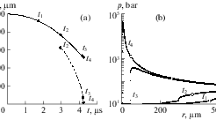Abstract
The possibility of increasing the efficiency of calculation of small axisymmetric non-sphericity of a radially convergent shock wave in a collapsing cavitation bubble by the Godunov method of increased order of accuracy is shown in the case the surfaces of the bubble and the shock wave are presented as a combination of the spherical component and its small perturbation in the form of a spherical harmonic of some degree \(n\). The dynamics of the vapor in the bubble and the surrounding liquid in the final high-speed stage of collapse is governed by the equations of gas dynamics closed by wide-range equations of state. Non-uniform moving radially-divergent grids are applied, condensing to the bubble surface. An increase in the calculation efficiency is achieved by decreasing the apex angle of the computational domain from (normally accepted) \(\pi/2\) to a value that is the minimum among nonzero angles \(\theta\) corresponding to the local extrema of the Legendre polynomial of degree \(n\) in \(\cos{\theta}\). This way of increasing the calculation efficiency was used to study the growth of small axisymmetric non-sphericity of a radially convergent shock wave in a collapsing cavitation bubble in acetone with a temperature of 273.15 K and a pressure of 15 bar in the case of the initial non-sphericity of the bubble in the form of even harmonics of degree \(n=6-18\). It was found that in the initial stage of convergence of the shock wave, where it turns into a strong one, its non-sphericity increases more slowly than during the subsequent convergence. In the initial stage, the growth rate of non-sphericity decreases with increasing \(n\). During the subsequent convergence, the non-sphericity of the shock wave grows, independently of \(n\), proportionally to its radius to the power of \(-1.12\).



Similar content being viewed by others
REFERENCES
D. J. Flannigan and K. S. Suslick, ‘‘Inertially confined plasma in an imploding bubble,’’ Nat. Phys. 6, 598–601 (2010).
C. C. Wu and P. H. Roberts, ‘‘Shock-wave propagation in a sonoluminescing gas bubble,’’ Phys. Rev. Lett. 70, 323–349 (1993).
W. C. Moss, D. B. Clarke, J. W. White, and D. A. Young, ‘‘Hydrodynamic simulations of bubble collapse and picosecond sonoluminescence,’’ Phys. Fluids 6, 2979 (1994).
R. P. Taleyarkhan et al., ‘‘Evidence for nuclear emissions during acoustic cavitation,’’ Science (Washington, DC, U. S.) 295 (5561), 1868–1873 (2002).
R. I. Nigmatulin, I. Sh. Akhatov, A. S. Topolnikov, et al., ‘‘The theory of supercompression of vapor bubbles and nano-scale thermonuclear fusion,’’ Phys. Fluids 17 (10), 1–31 (2005).
K. S. Suslick and D. J. Flannigan, ‘‘Inside a collapsing bubble: Sonoluminescence and the conditions during cavitation,’’ Ann. Rev. Phys. Chem. 59, 659–683 (2008).
J. J. Hinman and K. S. Suslick, ‘‘Nanostructured materials synthesis using ultrasound,’’ Top. Curr. Chem. 375 (1) (2008). https://doi.org/10.1007/s41061-016-0100-9
A. Yu. Dnestrovskij, S. A. Voropaev, et al., ‘‘Conditions of the formation of a shock wave under cavitation in hydrocarbon solutions,’’ Dokl. Phys. 65, 8–11 (2020).
A. A. Aganin and T. F. Khalitova, ‘‘Strong medium compression in a spheroidal cavitation bubble,’’ Uch. Zap. Kaz. Univ., Ser. Fiz.-Mat. Nauki 157, 91–100 (2015).
G. Guderley, ‘‘Powerful cylindrical and spherical compression shocks in the neighborhood of the centre of the sphere and of the cylinder axis,’’ Luftfahrtforschung 19, 302–312 (1942).
K. V. Brushlinskii, ‘‘Instability of the convergent spherical shock wave,’’ USSR Comput. Math. Math. Phys. 22, 1468–1479 (1982).
M. Murakami, J. Sanz, and Y. Iwamoto ‘‘Stability of spherical converging shock wave physics of plasmas,’’ Phys. Plasmas 22, 072703 (2015).
A. K. Evans, ‘‘Instability of converging shock waves and sonoluminescence,’’ Phys. Rev. E 54, 5004–5011 (1996).
A. Vallet, ‘‘Hydrodynamic modelling of the shock ignition scheme for inertial confinement fusion,’’ Doctoral Thesis (Univ. de Bordeaux, 2014).
Z. Somogyi and P. H. Roberts, ‘‘Stability of an imploding spherical shock wave in a van der Waals gas II,’’ Quart. J. Mech. Appl. Math. 60, 289–309 (2007).
C. C. Wu and P. H. Roberts, ‘‘Structure and stability of a spherical shock wave in a Van der Waals gas,’’ Quart. J. Mech. Appl. Math. 49, 501–543 (1996).
A. A. Aganin, T. F. Khalitova, and N. A. Khismatullina, ‘‘Numerical simulation of radially converging shock waves in the cavity of a bubble,’’ Math. Models Comput. Simul. 6, 560–572 (2014).
T. F. Khalitova, ‘‘Deformation of shock waves inside a bubble subjected to strong compression,’’ Vestn. NNGU 4, 2561–2563 (2011).
A. A. Aganin and T. F. Khalitova, ‘‘Small non-sphericity of a convergent shock wave arising in a cavitation bubble in acetone during its collapse,’’ J. Phys.: Conf. Ser. 1588, 012058 (2020).
R. I. Nigmatulin and R. Kh. Bolotnova, ‘‘Wide-range equation of state for organic liquids: Acetone as an example,’’ Dokl. Phys. 52, 442–446 (2007).
Author information
Authors and Affiliations
Corresponding authors
Additional information
(Submitted by D. A. Gubaidullin)
Rights and permissions
About this article
Cite this article
Aganin, A.A., Khalitova, T.F. Calculation of Small Deformations of a Radially Convergent Shock Wave Inside a Cavitation Bubble. Lobachevskii J Math 42, 1954–1960 (2021). https://doi.org/10.1134/S1995080221080023
Received:
Revised:
Accepted:
Published:
Issue Date:
DOI: https://doi.org/10.1134/S1995080221080023



